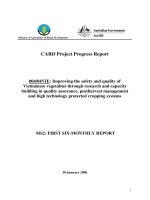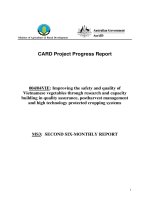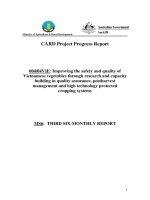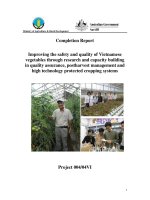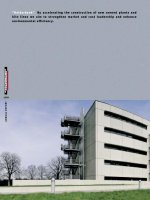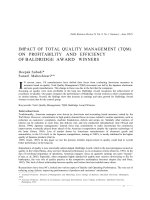Springer material flow management improving cost efficiency and environmental performance 2006 ISBN3790815918
Bạn đang xem bản rút gọn của tài liệu. Xem và tải ngay bản đầy đủ của tài liệu tại đây (12.79 MB, 212 trang )
Sustainability and Innovation
Coordinating Editor
Jens Horbach
University of Applied Sciences Anhalt, Bernburg, Germany
Series Editors
Eberhard Feess
RWTH Aachen, Germany
Jens Hemmelskamp
University of Heidelberg, Germany
Joseph Huber
University of Halle-Wittenberg, Germany
Ren Kemp
University of Maastricht, The Netherlands
Marco Lehmann-Waffenschmidt
Dresden University of Technology, Germany
Arthur P. J. Mol
Wageningen Agricultural University, The Netherlands
Sustainability and Innovation
Published Volume:
Jens Horbach (Ed.)
Indicator Systems for Sustainable Innovation
2005. ISBN 3-7908-1553-5
Bernd Wagner ´ Stefan Enzler
(Eds.)
Material Flow
Management
Improving Cost Efficiency
and Environmental Performance
With 54 Figures and 16 Tables
Physica-Verlag
A Springer Company
Professor Dr. Bernd Wagner
University of Augsburg
Centre for Further Training
and Knowledge Transfer
Universitåtsstraûe 16
86159 Augsburg
Germany
Dr. Stefan Enzler
imu Augsburg GmbH & Co. KG
Gratzmçllerstraûe 3
86150 Augsburg
Germany
Editorial Assistent: Kristin Hinz, B. A.
ISSN 1860-1030
ISBN-10 3-7908-1591-8 Physica-Verlag Heidelberg New York
ISBN-13 978-3-7908-1591-7 Physica-Verlag Heidelberg New York
Cataloging-in-Publication Data applied for
Library of Congress Control Number: 2005931362
This work is subject to copyright. All rights are reserved, whether the whole or part of
the material is concerned, specifically the rights of translation, reprinting, reuse of illustrations, recitation, broadcasting, reproduction on microfilm or in any other way, and
storage in data banks. Duplication of this publication or parts thereof is permitted only
under the provisions of the German Copyright Law of September 9, 1965, in its current
version, and permission for use must always be obtained from Physica-Verlag. Violations
are liable for prosecution under the German Copyright Law.
Physica is a part of Springer Science+Business Media
springeronline.com
° Physica-Verlag Heidelberg 2006
Printed in Germany
The use of general descriptive names, registered names, trademarks, etc. in this publication does not imply, even in the absence of a specific statement, that such names are
exempt from the relevant protective laws and regulations and therefore free for general
use.
Cover-Design: Erich Kirchner, Heidelberg
SPIN 11431565
88/3153-5 4 3 2 1 0 ± Printed on acid-free paper
Preface
Material flow management gets right to the core of industrial production
and its environmental impact. Basically, material flows are invariably at
the nucleus of industrial production. Ecological effects are initially caused
by materials: consumption and entropy of scarce resources as well as
emissions resulting from the production and use of products and consumer
goods.
It is only during recent years that the eco-efficient optimisation of these
material flows, which aims at reducing costs while simultaneously decreasing environmental impact, has become an explicit objective of both
practical and scientific activities and efforts. There has been a lot of
discussion, but little has been done.
This book provides an overview of the pertinent research and scientific
projects conducted between 1999 and 2005 in co-operation with industrial
companies; the projects were initiated and founded by the Bundesministeriumfur Bildung und Forschung (BMBF, Federal Ministry of Education
and Research).
This book illustrates the current diversity of existing operational
approaches and thus also points out synergetic co-ordination options. It
demonstrates the high, still unutilised potential for increasing the ecoefficiency of material flows: the long since existing, but yet unused
overlapping areas between cost reduction and simultaneous environmental
relief by means of efficient material utilisation. The reason for this
suboptimal material flow efficiency essentially lies in the currently still
low transparency of cross-departmental or cross-company material flows
(with regard to the flowing physical quantities and volumes - in detail the commercial costs/ values and flow times).
However, transparency alone is not sufficient unless there is crossdepartmental and cross-company efficient communication, information
exchange and co-operation between the stakeholders along the material
flows.
In the end, it will be necessary to make the wide variety of isolated
experiences and approaches available to a broader audience and, most of
all, implement them on a more extensive basis in the companies.
VI
Preface
The funding focus "Corporate Instruments for Sustainable Management" (DMA) and this resultant publication are intended to be a step in this
direction.
Augsburg, May 2005, Bemd Wagner
Contents
1
2
Introduction
Stefan Enzler
1.1
Brief Description
1.2
Brief Description
1.3
Brief Description
1.4
Brief Description
1.5
Brief Description
1
of CARE Research Project
of EPM-Kompas Research Project
of INTUS Research Project
of IC Research Project
of StreaM Research Project
Aspects of Material Flow Management
Stefan Enzler
2
3
4
5
6
7
2.1
2.2
The Term "Material Flow Management"
8
Stakeholders and Networks of Material Flow Management ..9
2.2.1 Stakeholders in Material Flow Management
9
2.2.2 Vertical and Horizontal Co-operations in Material
Flow Management (Networking)
13
2.3
Forms of Material Flow Management
15
2.3.1 Ecological Quality Improvement and Quality Assurance 16
2.3.2 Material Flow Related Service and Responsibility
16
2.3.3 Lifecycle Based Product Optimisation
16
2.3.4 Product-related Recycling and Disposal
16
2.4
Summary
17
References
18
3
Computer Aided Resource Efficiency Accounting
Timo Busch, Severin Beucker, Andreas Miiller
21
3.1
21
22
23
Introduction
3.1.1 Background
3.1.2 Macroeconomic Objective Definition
3.1.3 Eco-efficiency as a Strategic "Guide Rail"
for Enterprises
24
VIII
Contents
3.1.4 Data Diversity and Decision Support Systems
Methodological Approach
3.2.1 Definition and Limitations of Resource Efficiency
Accounting
3.2.2 Economic Dimension - Process Cost Accounting
3.2.3 Ecological Dimension - Material Intensity
3.2.4 Eco-efficiency: Objective Function
3.2.5 REA and Data Collection Levels
3.3
Case Study: Toshiba Europe
3.3.1 Initial Situation and Objective
3.3.1 Procedure
3.3.3 Results of the Resource Efficiency Accounting
at Toshiba
3.3.4 IT Based and Organisational Implementation of
Resource Efficiency Accounting at Toshiba
References
3.2
25
27
27
29
30
32
33
47
47
48
50
50
53
Measuring Environmental Performance with EPM-KOMPAS
Software Tool - Material Flow Analysis, Environmental
Assessment and Success Control
57
Edeltraud Giinther, Susann Kaulich
4.1
4.2
Decision Support: The Basic Principle
57
Willingness and Capability to Perform: Commitment,
Competence and Choice
58
4.3
Environmental Performance and Environmental Success:
What Should Be Measured?
59
4.4
The EPM-KOMPAS: How Does the Tool Work?
64
4.4.1 Step 1: Input/Output Balance
65
4.4.2 Step 2: Environmental Assessment and Selection of
Master Parameters
66
4.4.3 In Detail: Environmental Assessment Method for Master
Parameter Determination
66
4.4.4 Steps 3 and 4: Identifying Performance Drivers and
Determining Objectives
72
4.4.5 Steps 5 and 6: Establishing a Process Balance and
Selecting Measures
73
4.4.6 Step 7: Carrying Out the Environmental Success
Breakdown and Variance Analysis
74
4.4.7 In Detail: The Environmental Success Breakdown
74
Contents
4.4.8 Step 8: Review of Actions and Objectives
Practical Application: A Case Study
4.5.1 Data Collection
4.5.2 Stakeholder Analysis
4.5.3 Cause Analysis
4.6
Strategic Environmental Management and the
EPM-KOMPAS Options
4.7
Outlook
References
4.5
Integrated Controlling Based on Material and Energy Flow
Analysis - A Case Study in Foundry Industries
Christoph Lange, Andre Kuchenbuch
5.1
Introduction
5.1.1 The INPROCESS Project
5.1.2 Basics of Integrated Controlling
5.2
Phase Model for Introducing Integrated Controlling in
Foundry Companies
5.2.1 Phase 0: Information Requirements Analysis
5.2.2 Phase 1: Process Structure Analysis
5.2.3 Phase 2: Subprocess Analysis
5.2.4 Phase 3: Input-Output Analysis
5.2.5 Phase 4: Process Cost Analysis
5.2.6 Phase 5: Performance Indicator-supported Provision
of Information
5.3
Case Study: Model Foundry
5.3.1 Basic Structure of the Model Foundry
5.3.2 Phase 0: Information Requirement Analysis
5.3.3 Phase 1: Process Structure Analysis
5.3.4 Phase 2: Subprocess Analysis
5.3.5 Phase 3: Input-Output Analysis
5.3.6 Phase 4: Process Cost Analysis
5.3.7 Phase 5: Performance Indicator-supported Provision
of Information
5.4
Summary
References
IX
76
77
77
77
78
85
88
89
91
91
91
94
96
98
99
100
101
104
107
110
Ill
112
113
114
117
119
124
126
128
Contents
Environmental Accounting Instruments: Implementation &
Continuous Use - Concepts for the Application of
Input-Output Balance, Environmental Performance
Indicators and Flow Cost Accounting
131
Claus Lang'KoetZy Thomas Loew, Severin Beucker,
Michael Steinfeldt, Uwe Horstmann, Till Sieghart
6.1
6.2
6.3
6.4
6.5
6.6
Introduction
Research Project INTUS
Combination of Tools
Information Technology Support Concept
The Challenge of Organisational Integration
Case Study: Preparation of Corporate Input-Output
Balances and Environmentally Related Consumption
Quantity Analyses in SAP R/3
6.6.1 Initial Situation
6.6.2 Realisation of Eco Key in SAP R/3
6.6.3 IT Related and Organisational Implementation of
Eco Key
6.6.4 Eco Key Usage and Rollout in Group Division
6.6.5 Case Study Conclusion
6.7
Summary and Outlook
References
Efficient Closure of Material and Component Loops ~
Substance Flow Oriented Supply Chain Management
Martin Ploog, Wiethe Stolting, Marcus Schroter,
Thomas Spengler, Christoph Herrmann^ Rene Graf
7.1
7.2
7.3
131
132
134
138
141
145
145
146
148
151
152
154
156
159
Introduction
160
Procedure for Practical Realisation
163
Implementation of Information Concept
164
7.3.1 Agfa-Gevaert AG Information Sources
166
7.3.2 Creating Recycling Passports at Agfa-Gevaert AG
167
7.3.3 Use of Recycling Passports at Recycling Companies.... 167
7.4
Recycling
168
7.4.1 Calculation
168
7.4.2 Disassembly
171
7.4.3 Results of the Recycling Process
172
7.5
Re-use of Product Components from ADC 70
173
Contents
Spare Parts Supplying at Agfa-Gevaert AG, Using ADC
Compact Example
7.7
Outlook: Strategic Planning for Integrating Product
Component Re-use
7.8
Summary
References
XI
7.6
8
Developments in Material Flow Management:
Outlook and Perspectives
Bernd Wagner, Stefan Enzler
184
193
194
195
197
8.1
8.2
Existing Obstacles to Material Flow Management
197
Required Developments in Material Flow Management... 198
8.2.1 Standardised Data Collection and Evaluation with ERP
System Interface
199
8.2.2 Industry-specific Solutions
199
8.2.3 Supplementation of Supply Chain (Value-added Chains)
Evaluations with Information Flow Analyses
200
8.2.4 Internal Business Models for a Culture of Innovation ...200
8.2.5 Dissemination and Networking of Research Results
200
8.3
Summary
201
About the Authors
203
1 Introduction
Stefan Enzler
imu augsburg GmbH & Co.KG, Augsburg/ Germany
Email:
Within the scope of the German Federal Government's "Research for the
Environment" programme, the Bundesministerium fur Bildung und
Forschung [BMBF (German Federal Ministry of Education and Research)]
is funding research work on the subject of integrated environmental
protection. Within this programme, various topics are compiled into
funding focuses. Since 1999, the BMBF funding focus "Corporate
Instruments for Sustainable Management" (INA) has bundled numerous
research and development work on the following topics:
• IT tools for sustainable management
• Controlling tools for sustainable management (monetary and nonmonetary assessment tools)
• Planning tools for sustainable management (operative and strategic
planning tools)
• Communication tools for sustainable management.
Within these four funding fields, sustainability approaches are examined
on an internal and cross-company basis, which are aligned both along
value-added chains and span across the various levels of corporate
function areas (such as design, work planning/ scheduling, production
planning, management and control systems, accounting and controlling).
Within the INA funding focus, research and development resulted in the
emergence of practically-oriented concepts for integrating the requirements of sustainable management into entrepreneurial and business
decision-making. The starting point for the developed solutions is the daily
routine of the company as well as the current decision-making patterns of
the consumers and producers. The results of the research should now
contribute to fully utilising the potentials of sustainable management in the
Stefan Enzler
company, provide a new framework for economic research and initiate
standardisation processes geared towards sustainable management.
In order to integrate the research and development tasks and moreover,
enable the consideration of cross-project topics, cross-project working
groups have to be organised. They represent an essential tool for effective
interdisciplinary co-operation within the funding focus.
This publication summarises the results of both the "Material Flow
Management and Recovery Systems" working group and the projects that
were conducted. The focus of the "Material Flow Management and
Recovery Systems" working group is at the core of the environmental
problem: material flows and the resource consumption and emissions
associated with them. The objective of the various practice-oriented
projects is to reduce material related environmental pollution in conjunction with economic optimisation. To this end, new economically sound
closed loop supply chain options should be taken into account for the
purpose of promoting an utilisation of resources that is as intensive,
sustainable and low-entropy as possible. Material flow management thus
deals directly with the root of the problem, since material flows and their
impact are direct causes of ecological problems. Accordingly, the
reduction or substitution of material flows can directly contribute to a
decrease in environmental pollution. Moreover, such changes usually
result in a reduction of costs at the same time. The working group and the
projects conducted concerned themselves with providing new impetuses
and ideas to the dynamic structures between ecology and economy.
To present these results, this publication first describes a content-based
framework on the topic of material flow management. The individual
projects and their conclusions are introduced next. The conclusion then
provides a comprehensive summary of the end results from the crossproject meetings as well as prospects for further possible activities.
Since the presentation of the results of the completed research projects
is the main focus of this publication, a brief overview of the individual
projects is provided here for informational purposes.
1.1 Brief Description of CARE Research Project
The BMBF-funded research project "CARE - Computer-Aided Resource
Efficiency Accounting in Small and Medium Sized Enterprises" starts
from the current state of (environmental) cost accounting and ecological
information systems and takes it as a basis for developing an application
method that expands the existing economic controlling systems of
enterprises by adding ecological information and combines them into an
Introduction
3
integrated information system. The Resource Efficiency Accounting
(REA) system, a tool developed by the Wuppertal Institute (Wuppertal,
Germany), serves as the methodical framework for this. Integrating the
results of the REA into corporate controlling creates a decision-making
basis for Management in regards to the economic and ecological assessment and optimisation of production processes and products.
The analysis and assessment of the resource efficiency of processes and
products requires lifecycle-wide data and information. Such data is
available from business information systems as well as external data
sources. For this, data concerning internal material and energy flows are
supplemented in the form of MI values by resource consumption data from
upstream and, if applicable, downstream production steps and/or the
utilisation phase.
To enable more efficient use of the data for analysing internal processes
and products, a standard for exchanging data between business information
systems (Enterprise Resource Planning systems, ERP) and Environmental
Management Information Systems (EMIS) was developed in the course of
the CARE project and published in the form of a Publicly Available
Specification (PAS) in co-operation with the DIN institute. In the future,
this data standard will facilitate the exchange of data between the different
information systems and make the data available for the economic-ecological assessment of production processes and products.
The CARE project was able to demonstrate how the systematic
collection and processing of data related to internal material and energy
flows as well as costs associated with them can improve the quality of
company and business decisions with respect to sustainable management.
The results of the basic project were tested and implemented in practice at
the corporate co-operation partners: Nolte Mobel, Toshiba Europe GmbH
and Muckenhaupt & Nusselt.
1.2 Brief Description of EPIVI-Kompas Research Project
In conjunction with the Saxon industrial partners, and by commission of
the BMBF, the Professorship of Business Administration, with a particular
focus on Environmental Management, at the Technische Universitat (TU)
Dresden (Dresden University of Technology, Germany) has developed, in
interdisciplinary co-operation with information scientists and mechanical
engineers at the TU Dresden, a tool based on the approach of integrated
management of environmental and risk aspects, which can be used as both
a stepping stone for introducing an environmental management system
(EMS) as well as a tool for the systematic further development of an
Stefan Enzler
existing EMS. The free software developed in the scope of the project,
EPM-KOMPAS, can be deployed for individually definable system
borders (e.g. process, location, product, etc.) and supports companies in
handling hazardous materials and waste, designing internal material and
energy flows, setting environmental objectives, evaluating environmental
protection measures and preparing reports for authorities. Along with the
classic material flow analysis, also implemented are a "silent moderator"
that guides users through the software as well the KOMPAS assessment
(according to Giinther/ Kaulich) for significant environmental aspects and
ecological results breakdown.
The KOMPAS software joins the ranks of fiirther research activities
related to measuring the environmental performance of transport processes, products from the chemicals industry and products from the
medical textiles sector, which are being conducted in the "Environmental
Performance Measurement (EPM)" competence centre at the TU Dresden.
1.3 Brief Description of INTUS Research Project
In the "D^TUS - Operationalisation of Environmental Accounting Instruments through the Effective Use of Environmental Management Information Systems'' research project, concepts were developed for facilitating
the introduction of controlling tools into the internal environmental
management systems of enterprises. The new concepts relate to the three
key problems with which companies are faced when striving to optimise
the internal provision of information in regards to environment-oriented
management. Areas to be considered here include:
• the suitability of the various environmental accounting tools;
• the provision of the tools by way of information technology (IT); and
• the organisational implementation during the introductory phase and in
long-term utilisation.
In co-operation with four companies, practical solutions for the ITaided provision of environmental performance indicators and input-output
balances as well as additional information for efficient and proactive
environmental protection were developed. Amongst others, an environmental performance indicator system was created and realised within SAP
R/3 at Germany-based glass manufacturer SCHOTT. Experience in the
medium-sized enterprise sector was gained at the Gohring company, a
manufacturer of wood furniture. At Gohring, a performance indicator
system was developed, and moreover, the company can now access an
input-output balance directly from the Navision Financials ERP system.
Introduction
5
The research project also examined the suitability of special software
programs for modelling and analysing internal material flows. In addition,
a further focus was placed on organisational issues, since it was found that
the deployment of IT solutions alone is not sufficient for the successful
implementation of a controlling tool.
1.4 Brief Description of IC Research Project
The basis of this contribution is the BMBF sponsored project entitled "IC
- Development of an Integrated Controlling Concept Based on a Processoriented Costing System with Regard to Optimised Material and Energy
Flows in Iron, Steel and Malleable Iron Foundries" (INPROCESS). The
project is an interdisciplinary research project that aims at creating
practically-oriented controlling tools in a sustainable development context.
The expansion of costing systems in regards to environmental protection
represents an important basis for the development of an integrated
controlling concept. The approaches presented in the literature were
already analysed prior to the project; both differentiating and integrating
approaches were found. Within the scope of the project, a non-monetary
integrated environmental activity-based costing method was developed,
which records material and energy flows as well as internalised environmental costs in an integrating system and allocates them to identical
reference objects. A "controlling-friendly" cost management of both
environmental costs and environmental impact is only made possible by an
integrated assessment of the degree to which economic and ecological
objectives are achieved.
In addition to laying the theoretical foundation, the methodological
approach comprises case studies examining a total of nine companies, at
which individual focal tasks of the project were put into practice. The main
results of this project are:
• the development of a phase model for implementing integrated controlling in foundry companies;
• the development of a model foundry;
• the preparation of industry guidelines for distributing the results; and
• an IT-aided comparison of foundry-specific software.
Stefan Enzler
1.5 Brief Description of StreaM Research Project
The BMBF funded project "StreaM - Material Flow Based Closed Loop
Supply Chain Management in the Electro(nics) Industry for the Purpose of
Closing Material Loops" was conducted from January 2001 to April 2004
at the Technical University of Braunschweig (TU Braunschweig) by the
Institute of Business Administration, Department of Production Management, in co-operation with the Institute of Machine Tools and Production
Technology, Department of Product and Life Cycle Management. The
Agfa-Gevaert AG (Munich/ Germany) and Electrocycling GmbH (Goslar/
Germany) companies were brought into the project as industrial partners.
In light of the fact that in the future, recycling companies should be
integrated into the supply chains of product manufacturers, particularly
due to the requirements for expanded product responsibility, the StreaM
project aims to provide information technology tools as well as strategic
and operative planning tools for integrated, material flow based, crosscompany supply chain management in the electronics industry, for the
purpose of facilitating companies in fully utilising the resultant ecological
and economic optimisation potentials. For the development of the IT tool,
the concept of the recycling passport used by Agfa-Gevaert AG was
applied and an Internet-based communication was platform created, taking
into account the information requirement(s) arising from the various
recycling options; the platform interlinked the product development phase
with the post-use phase. The concept was implemented in a prototype. The
developed strategic tools primarily focus on the support of long-term
cross-company planning in terms of the return and re-use of product
components within the scope of spare parts management. In this context, a
prototype software for a strategic planning tool was developed on the basis
of the "systems dynamics" simulation method. These operative planning
tools comprise two main tasks:
• the development of a concept for designing business processes related to
the order processing for reusing products components in spare parts
management, and
• the development of a production planning, control and management
system for recycling companies based on the methods of activity-based
analysis and operations research.
The developed tools were validated over the course of several comprehensive case studies. Corresponding recommendations for action for the
companies and for general politics were then derived from the implementation and the experience gained from the case studies.
2 Aspects of Material Flow Management
Stefan Enzler
imu augsburg GmbH & Co.KG, Augsburg/ Germany
Email:
The term material flow management covers a broad spectrum of methods
and approaches in the literature. In general, material flow management
refers to the analysis and specific optimisation of material and energy
flows that arise during the manufacturing of products and provision of
services. Material flow management can focus on very different levels of
consideration. When defining system borders for material flow management, the following areas can be specified:'
•
•
•
•
•
•
Company-internal processes
An entire company
Supplier relationships along a value-added chain
An entire value-added chain
A region
A nation.
This flexibility with respect to system borders leads us to another key
topic of material flow management: the management of material flows.
This extends beyond a merely material or technical aspect the focus lies on
a system to be optimised, not an individual product or material.^ The
approach in such a systematic analysis of material flow management is the
interlinking of a purely technical-economic approach (corporate inputoutput optimisation) with an ecological value (system) in regards to
sustainability and future potentials. Successful material flow management
thus also links the structural analysis of material flows with the data
' See Staudt/ Auffemiann/ Schroll 2002, pp. 65 et seq.; Sterr 1998, p. 4; Wietschel
2002, p. 5; Mahammadzadeh/ Biebeler 2004, p. 10 et seq.
2 See Marsmann 1998, p. 10
8
Stefan Enzler
available in business information systems. A direct quantification of the
quantity/ volume and costs of material flows points out the way towards
new cost-cutting options.^ Consequently, material flow management is first
and foremost characterised by interdisciplinarity and networking on the
basis of a normative orientation.^ In addition to a clarification of the term,
aspects of material flow management also comprise the consideration and
examination of stakeholders and networks as well as the various forms of
material flow management.
2.1 The Term "Material Flow Management"
In its demand for a material flow management of all material systems, the
"Protection of Mankind and the Environment" Commission of Inquiry of
the 12^^ Deutsche Bundestag (Lower House of the German Parliament)
presented a quantitative and qualitative new challenge for governments,
companies, science and research. At the same time, the Commission of
Inquiry also provided a basic definition of the term "material flow
management" from a macroeconomic standpoint:
"Management of material flows by the involved stakeholders refers to the
objective-oriented, responsible, integrated and efficient controlling of material
systems, with the objectives arising from both the economic and ecological sector
and with the inclusion of social aspects. The objectives are determined on a
company level, within the scope of the chain in which stakeholders are involved or
on a national level."^
Additional publications have concretised and supplemented the Commission of Inquiry's definition, e.g. by differentiating between internal and
cross-company material flow management. Whereas an internal material
flow refers to the movements of substances or materials within a company,
a cross-company {external) material flow describes the path of a material
along the value-added chain.^ The path of cross-company material flow
management is also described as the product line or product lifecycle, from
the input of raw materials, manufacturing, distribution and use and
consumption up to disposal.^ Sterr defines material flow management as a
"objective-oriented, structured handling of materials along the value-added
^ See Enzler/ Krcmar/ Pfenning/ Scheide/ Strobel 2005, pp.63 et seq.
^ See Brickwedde 1999, p. 13
^ Enquete-Kommission (Commission of Inquiry) 1994, pp. 549 et seq.
^ See Staudt et.al. 2000, p. 6
^ See Zundel etal. 1998, p. 319
Aspects of Material Flow Management
9
chain, including the interests of stakeholders who are directly or indirectly
involved in it"^ The definitions set forth by Sterr and the Commission of
Inquiry clearly make the stakeholders the focus of attention within the
scope of material flow management. A purely ecological and material
viewpoint transforms into a stakeholder perspective that takes into account
the economic concerns as well as the incentives and motivation on the part
of the stakeholders.^
2.2 Stakeholders and Networks of Material Flow
Management
2.2.1 Stakeholders In Material Flow Management
Material flow management comprises new forms of co-operation and
communication as well as new organisational methods and models, since it
involves the co-operation of stakeholders from a wide range of specialised
disciplines and educational levels. This applies from both an internal and
cross-company standpoint. However, material flow management should
not only be seen from a purely stakeholder co-operation angle. Competition and conflicts also have an impact on material flow management,
since they create new perspectives and decision-making structures and
point out existing weak spots.^^ The primary participating stakeholders
vary depending on the system borders of material flow management
(internal, cross-company, regional, supraregional). Nevertheless, the success of material flow management for all stakeholders rests on the same
factors: motivation and expertise as well as assertiveness and power.^' The
basic idea underlying the necessity of material flow management can be
attributed to the fact that the involved material flow stakeholders cannot
communicate, or cannot communicate in a objective-oriented manner, with
each other and accordingly optimise the material flow without sufficient
and satisfactory networking and co-ordination. As already indicated, the
reasons for this can be very diverse, which explains the need for research
in regards to developing methods for methods material flow management.
In principle, the stakeholders involved in material flow management can
be divided into two categories: ^^
« Sterr 1998, p. 3
9 See Schneidewind 2003, p. 17
'«See de Man/ Glaus 1998, p. 72
^^ See Heck/ Knaus 2002, p. 27 and de Man/ Glaus 1998, p. 73
»2 See Heck/ Knaus 2002, p. 27
10
Stefan Enzler
• direct material flow stakeholders, and
• indirect material flow stakeholders.
The direct or primary stakeholders are the actual material flow
managers and have a direct influence on the material flows. The indirect
stakeholders (e.g. commercial enterprises) only indirectly impact the material flows by, e.g., setting up the general framework conditions for the
respective value-added chain.'^ These two stakeholder categories can be
further subdivided into five stakeholder types: *^
1. Economic stakeholders who directly influence material flows: these are
stakeholders who have the task of directly handling, controlling and
monitoring material flows. These include, e.g., people or departments in
production companies.
2. Economic stakeholders whose decisions influence the materials-related
decisions made by other stakeholders: in this context, for example, the
purchasing decisions and product ranges of commercial enterprises
influence many upstream material flows. Such indirect material flow
management affects the actions of the direct material flow stakeholders.
Other examples of this are banks or insurance agencies.
3. Economic stakeholders who set the framework conditions for the
material flow management of a sector, industry or production chain:
this includes stakeholders who create favourable framework conditions
for the direct stakeholders in material flow management, e.g., through
the centralisation of information systems, providing expertise or
mediating in the competitive situation between stakeholders. Such tasks
are undertaken by traditionally horizontally oriented associations or by
vertically organised co-operative structures.
4. Governmental or administrative stakeholders who set the framework
conditions for the material flow management of economic stakeholders
(the three types described above): These stakeholders enable and/or
promote material flow management by setting and organising relevant
political framework conditions.
5. Other stakeholders who influence the material flow management of all
other stakeholders: These include, for example, consumer organisations,
environmental protection associations, standardisation institutions and
other NGOs that attempt to influence the actions of all of the abovementioned four types of stakeholders by way of their activities.
'^ See de Man/ Claus 1998, p. 72
'^ See de Man, R. 1994
Aspects of Material Flow Management
11
The "Protection of Mankind and the Environment" Commission of
Inquiry of the 12* Deutsche Bundestag analysed the stakeholders of material flow management. In this context, trade and industry (e.g. retailers)
as well as the government were emphasised as the central stakeholders.^^
Upon a closer examination, however, the government did not directly concern itself with the management of material flows, but rather influenced
the actions of the economic stakeholders by setting the political action
framework. This framework includes, for example, the definition of
environmental policy objectives, the specification of legal framework
conditions (e.g. by means of the Kreislaufwirtschafts- und Abfallgesetzl
German Closed Substance Cycle and Waste Management Act), the
development of economic incentives as well as the collection and distribution of ecological information, public relations activities and educational
policy.'^ The tasks of the government thus relate more to material policy
than material flow management.'"^
According to the definition of the Commission of Inquiry, material
policy and material flow policy comprises "all political measures that
influence the type and extent of materials supply and usage as well as
waste treatment and storage in order to secure, in the long term, the
material basis of the economy in view of limited resources and the
restricted pollution-bearing capacity of the environmental media"'^
Taking this approach as a basis, a task and responsibility demarcation
between the economic stakeholders and the government can be derived.
With its material flow policy, the government sets up the relevant framework conditions, while the actual structure and design of material flow
management, in terms of the planning, organisation, realisation, monitoring and controlling of internal and corporate material flows, is the
responsibility of the trade and industry.'^
*^ See Enquete-Kommission (Commission of Inquiry) 1994, pp. 591 et seq.
'^ See Henseling 2001, pp. 372 et seq.
1^ See Henseling 1998, p. 19
'^ Enquete-Kommission (Commission of Inquiry) 1994, p. 719
'^ See Mahammadzadeh/ Biebeler 2004, pp. 7 et seq.
12
Stefan Enzler
The following diagram illustrates the distribution of tasks within the
scope of material flow managementr^"
GOVERNMENT
^
^
7^/^
Economic
Stakeholders
j^
Material Flow
Systems
A:
B:
1:
2:
3:
Materia] flow nianagemsnt of economic
staketiolders
Fnarnework conditions by means of
material flow policy
Infomnation about material flows to
government
Infomnation about material management
of economic staketiolderB
Material flow infomnation abojt materal
flow management
'\
J
Fig. 2.1. Distribution of tasks within the scope of material flow management
between economic stakeholders and the government (source: Henseling 1998, p.
19)
Schneidewind considers the possibility of the controlled management of
material flows by their stakeholders and thus the existence of material flow
managers to be almost fictitious. From his point of view, material flow
design is a function of the close interconnection of actions, which individual stakeholders can hardly deliberately influence.^' This underlines the
complexity of this task, and points out the fact that that the stakeholders
involved in material flow management and the underlying organisation are
not to be seen as purely rational, constantly co-operative, unbiased information processing machines; their corresponding vested interests also play
a role. Accordingly, the development of a homogeneous perception of
material flows and information flows is one of the central tasks of material
flow management; only then can stakeholders design material flows in a
co-ordinated and objective-oriented manner.^^ The inclusion of the various
stakeholders in the shared conception and visualisation of material flows
can create a uniform perspective, a uniform language as well as an inte20 See Henseling 1998, p. 19
2^ See Schneidewind 2003, pp. 17 et seq.
22 See imu augsburg GmbH&Co.KG/ Zentrum fiir Weiterbildung und Wissenstransfer, Universitat Augsburg (Centre for Further Training and Knowledge
Transfer, University of Augsburg/ Germany) 2003, pp. 4 et seq.
Aspects of Material Flow Management
13
grated concept of material flow management.^^ After examining individual
stakeholders along with their responsibilities and task areas, a potential cooperation form of material flow management has to be analysed next. The
direct influence sphere of an individual stakeholder involved in a material
flow management rarely extends beyond one or two links of the valueadded chain. Usually, there is no direct causality between the activities of a
raw material producer and a recycler.
Since company co-operations that span across many links of the valueadded chain are generally the exception, material flow management in
practice concerns specific areas of the networked material flows and
stakeholder relationships.^"* De Man has derived the following "rules" from
extensive experience with actual material flow oriented co-operations in
practice:^^
• Cross-stakeholder and shared analysis and visualisation of the material
flows to be designed
• Objective-oriented communication about the material flows to be
designed
• Definition of realistic ecological objectives with the explicit inclusion of
economic goals
• Realistic assessment of the enterprise's own role
• The aim for forms of co-operation that are compatible with the economic reality
• Gradual and systematic implementation of material flow management
• Assurance that the decision-maker(s) of a material flow management are
provided with action-relevant information concerning the quantities/
volumes and values of the material flows.
2.2.2 Vertical and Horizontal Co-operations in Material Flow
Management (Networking)
Co-operations in material flow management are formed for a variety of
reasons. The motivation for co-operations arises from the following reasons or a combination thereof:^^
• Personal commitment and company culture
• Experience in environmental (protection) management
2^ See Strobel, van Riesen, Berger 2002, pp. 84 et seq.
^^ See de Man/ Haralabopoulou/ Henseling 1998, p. 24
25 See de Man 1999, pp. 64 et seq. and Strobel/ Miiller 2003, pp. 122 et seq.
2^ See de Man/ Haralabopoulou/ Henseling 1998, pp. 21 et seq.


